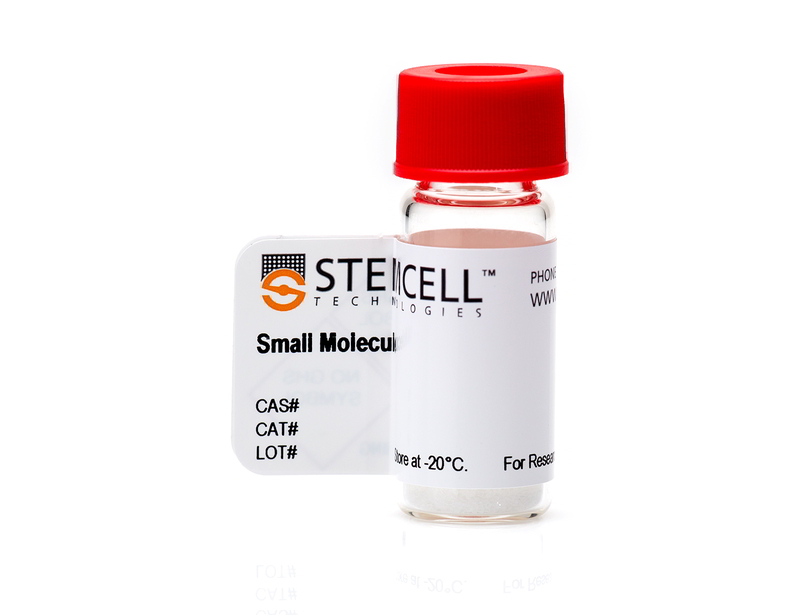概要
TG101348 is an inhibitor of Janus kinase 2 (JAK2) with an IC₅₀ of 6 nM. It also inhibits related kinases fms-related tyrosine kinase 3 (FLT3), RET, and JAK3 with less potent activity, having IC₅₀ values of 25, 17 and 169 nM, respectively (Pardanani et al.). It is proposed to bind to the ATP binding pocket of its kinase targets (Zhou et al.).
CANCER RESEARCH
· Inhibits growth of Ba/F3 cells expressing JAK2 V617F or MPL W515L mutations (Pardanani et al.).
· Reduces tumor cell burden and increases survival in mouse models of JAK2 V617F-induced hematopoietic and myeloproliferative disease (Pardanani et al.; Wernig et al.).
· Sensitizes erlotinib-resistant non-small cell lung cancer cells to erlotinib treatment in vitro and in a mouse xenograft model (Zhang et al.).
· Displaces BRD4 from chromatin and suppresses c-MYC expression in multiple myeloma cells in vitro (Ciceri et al.).
CANCER RESEARCH
· Inhibits growth of Ba/F3 cells expressing JAK2 V617F or MPL W515L mutations (Pardanani et al.).
· Reduces tumor cell burden and increases survival in mouse models of JAK2 V617F-induced hematopoietic and myeloproliferative disease (Pardanani et al.; Wernig et al.).
· Sensitizes erlotinib-resistant non-small cell lung cancer cells to erlotinib treatment in vitro and in a mouse xenograft model (Zhang et al.).
· Displaces BRD4 from chromatin and suppresses c-MYC expression in multiple myeloma cells in vitro (Ciceri et al.).
技术资料
| Document Type | 产品名称 | Catalog # | Lot # | 语言 |
|---|---|---|---|---|
| Product Information Sheet | TG101348 | 73472, 73474 | All | English |
| Safety Data Sheet | TG101348 | 73472, 73474 | All | English |
数据及文献
Publications (5)
Oncotarget 2015
JAK2 inhibitor TG101348 overcomes erlotinib-resistance in non-small cell lung carcinoma cells with mutated EGF receptor.
Abstract
Abstract
Non-small cell lung cancer (NSCLC) patients with epidermal growth factor receptor (EGFR) mutations are responsive to EGFR-tyrosine kinase inhibitor (EGFR-TKI). However, NSCLC patients with secondary somatic EGFR mutations are resistant to EGFR-TKI treatment. In this study, we investigated the effect of TG101348 (a JAK2 inhibitor) on the tumor growth of erlotinib-resistant NSCLC cells. Cell proliferation, apoptosis, gene expression and tumor growth were evaluated by diphenyltetrazolium bromide (MTT) assay, flow cytometry, terminal deoxynucleotidyl transferase biotin-dUTP nick end labeling (TUNEL) staining, Western Blot and a xenograft mouse model, respectively. Results showed that erlotinib had a stronger impact on the induction of apoptosis in erlotinib-sensitive PC-9 cells but had a weaker effect on erlotinib-resistant H1975 and H1650 cells than TG101348. TG101348 significantly enhanced the cytotoxicity of erlotinib to erlotinib-resistant NSCLC cells, stimulated erlotinib-induced apoptosis and downregulated the expressions of EGFR, p-EGFR, p-STAT3, Bcl-xL and survivin in erlotinib-resistant NSCLC cells. Moreover, the combined treatment of TG101348 and erlotinib induced apoptosis, inhibited the activation of p-EGFR and p-STAT3, and inhibited tumor growth of erlotinib-resistant NSCLC cells in vivo. Our results indicate that TG101348 is a potential adjuvant for NSCLC patients during erlotinib treatment.
Leukemia 2014
Specificity and mechanism-of-action of the JAK2 tyrosine kinase inhibitors ruxolitinib and SAR302503 (TG101348).
Abstract
Abstract
Nature chemical biology 2014
Dual kinase-bromodomain inhibitors for rationally designed polypharmacology.
Abstract
Abstract
Concomitant inhibition of multiple cancer-driving kinases is an established strategy to improve the durability of clinical responses to targeted therapies. The difficulty of discovering kinase inhibitors with an appropriate multitarget profile has, however, necessitated the application of combination therapies, which can pose major clinical development challenges. Epigenetic reader domains of the bromodomain family have recently emerged as new targets for cancer therapy. Here we report that several clinical kinase inhibitors also inhibit bromodomains with therapeutically relevant potencies and are best classified as dual kinase-bromodomain inhibitors. Nanomolar activity on BRD4 by BI-2536 and TG-101348, which are clinical PLK1 and JAK2-FLT3 kinase inhibitors, respectively, is particularly noteworthy as these combinations of activities on independent oncogenic pathways exemplify a new strategy for rational single-agent polypharmacological targeting. Furthermore, structure-activity relationships and co-crystal structures identify design features that enable a general platform for the rational design of dual kinase-bromodomain inhibitors.
Cancer cell 2008
Efficacy of TG101348, a selective JAK2 inhibitor, in treatment of a murine model of JAK2V617F-induced polycythemia vera.
Abstract
Abstract
We report that TG101348, a selective small-molecule inhibitor of JAK2 with an in vitro IC50 of approximately 3 nM, shows therapeutic efficacy in a murine model of myeloproliferative disease induced by the JAK2V617F mutation. In treated animals, there was a statistically significant reduction in hematocrit and leukocyte count, a dose-dependent reduction/elimination of extramedullary hematopoiesis, and, at least in some instances, evidence for attenuation of myelofibrosis. There were no apparent toxicities and no effect on T cell number. In vivo responses were correlated with surrogate endpoints, including reduction/elimination of JAK2V617F disease burden assessed by quantitative genomic PCR, suppression of endogenous erythroid colony formation, and in vivo inhibition of JAK-STAT signal transduction as assessed by flow cytometric measurement of phosphorylated Stat5.
Leukemia 2007
TG101209, a small molecule JAK2-selective kinase inhibitor potently inhibits myeloproliferative disorder-associated JAK2V617F and MPLW515L/K mutations.
Abstract
Abstract
JAK2V617F and MPLW515L/K represent recently identified mutations in myeloproliferative disorders (MPD) that cause dysregulated JAK-STAT signaling, which is implicated in MPD pathogenesis. We developed TG101209, an orally bioavailable small molecule that potently inhibits JAK2 (IC(50)=6 nM), FLT3 (IC(50)=25 nM) and RET (IC(50)=17 nM) kinases, with significantly less activity against other tyrosine kinases including JAK3 (IC(50)=169 nM). TG101209 inhibited growth of Ba/F3 cells expressing JAK2V617F or MPLW515L mutations with an IC(50) of approximately 200 nM. In a human JAK2V617F-expressing acute myeloid leukemia cell line, TG101209-induced cell cycle arrest and apoptosis, and inhibited phosphorylation of JAK2V617F, STAT5 and STAT3. Therapeutic efficacy of TG101209 was demonstrated in a nude mouse model. Furthermore, TG101209 suppressed growth of hematopoietic colonies from primary progenitor cells harboring JAK2V617F or MPL515 mutations.

 网站首页
网站首页





